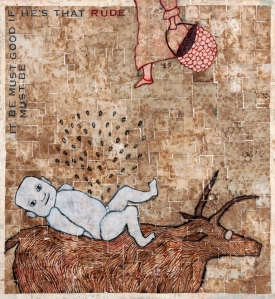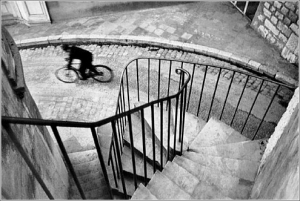(originally posted October 13, 2010)
-
The compulsion to make art has been with us for 17,000 years. For most of that time, the foremost question asked of the artist (perhaps second only to where’s the rent) has been why do you do it ~ where does this unstoppable urge to create come from? It’s a fascinating question especially if you’ve never had the calling, but beware the loquacious artist ~ Picasso pops to mind ~ who can come up with what sounds like a dazzling answer to what is ultimately a goose chasing question.
“You might as well ask me why I get out of bed in the morning,” an artist friend once explained, to this day the most refreshingly honest answer I’ve heard. By and large, art is made by people because ~ excuse the double negative ~ they can’t not make it. Doesn’t matter whether the art they make is good or bad. In your or anyone else’s opinion. They make art because, just like getting up in the morning, there is simply no alternative for them. Even in an extreme case, like van Gogh, anybody out there really think he wouldn't have flicked the switch in exchange for a normal, but art free life? He couldn't, not didn't. And constant use of his messed up mental health by art critics the world over as an explanation of his work is not just a ruse, it’s an insult to his genius.
An infinitely more interesting question is why we need art, what we see in it that is so intrinsically different from what we see just walking around, living our lives. Surely art explains the world to us, but while we can’t argue that context is unimportant, don’t trust history alone for an answer as to why you respond so deeply to one artist’s work, while you are left cold by another’s. In any case, the historical “reasons” we make art change every few hundred (or thousand) years. Since we’ve been keeping track we’ve gone from religion (with God the Über curator) to documentation (Vermeer and the Camera Obscura onward) to a need to explore the psyche (Freud and the Surrealist Movement did a nice tango on this one). For the last few decades art has been obsessed with finding meaning in materialism ~ you can thank Andy Warhol for the soulless Jeff Koons generation. My point is that while context is important, something else is up with our fascination, our need to look at and experience art. Is it finding grace? Is it looking in the mirror? Is it seeing our worst fears exposed?
A few years ago I dragged the family to NYC to see a Gustav Klimt exhibit, 8 paintings and a 120 drawings, at the Neue Galerie, Ronald Lauder’s exquisite private museum on the edge of Central Park. Though one of the most published artists in history, endless squabbles over Klimt’s legacy has made viewing more than one painting at time nearly impossible. The exhibit did not disappoint, but what happened unexpectedly while I was there set me thinking about context in a whole new light. Starting out in poverty, Klimt trained at the Vienna School of Arts and Crafts, immediately gaining acceptance and public commissions by Emperor Franz Joseph I. But instead of following a proscribed career, in 1887 he founded the Vienna Secession, a controversial group that encouraged unconventional artistic expression, invited exhibits by foreigners, and published a manifesto that debunked the myth that any one artistic style ~ especially what was in vogue at the time ~ should rein supreme. In short, at the turn of a century that would see two world wars change the map of Europe and, not least, the direction of art forever, Klimt helped push the envelope. Even when briefly shunned by society ~ his work deemed pornographic by every quarter that had once supported him ~ he defied conventions of the day, broke from tradition and become one of the most successful artists of all time.
-
Towards the end of the day I found myself standing in front of Klimt’s portrait of Adele Bloch-Bauer. The painting, which had been purchased by Lauder for $135 million ~ the highest price ever paid for a single work at the time ~ depicts a beautiful, fragile Jewish woman engulfed in a gilded, intricately decorated world that we know from history was on the precipice of extinction. Lush, subdued color draws the viewer into a universe that cossets yet distinguishes the female form from the fabric of her history. Light skims off the surface of burnished gold leaf, while intricate ornamental detail is eloquently rendered with flowing sinuous lines. Egyptian, Byzantine, Japanese influences, arguably all present, are subsumed by techniques that speak to no known style at all. What seems a sharp edged nod to a Dürer engraving catches in the light and disappears, only to be replaced by a soft tonal mosaic that brings ~ of all people ~ the neo-impressionist Seurat to mind.
As I stood there, a nine-year-old girl who had pulled away from her mother in another gallery came to stand beside me. While all these thoughts were going through my mind, she shifted uncomfortably from side to side. Like it, I asked? Yeah, she said, gnawing at her sleeve, but why is she so sad? Is she, I countered, to which the girl’s eyes, which had been darting around the canvas, looked directly into mine and held for a good five count ~ eons for a nine year old. The only thing free of her body is her mind, she replied. A non-contextual response, to be sure, but she had nailed it. In that moment, somewhere between the two of us, Klimpt’s ghost stirred.
 In a few week’s time the question of context will become particularly relevant as the studio mounts Susan Preston’s “One Button Off,” the last show of this exciting and transitional year for us. Susan is one of the most well known and ~ though she would be the last to admit it ~ beloved members of our community. She and her husband Lou have created, in Preston of Dry Creek Farm and Winery, a living agrarian document that eloquently tells a deeply political story which has been instrumental in helping to inform Sonoma County’s embrace of sustainability. The edible gifts of their working farm, which exist so successfully alongside their vineyards, winery and tasting room, have also helped expand a previously limited viticultural agenda for Sonoma that was up to now scarily Napa bound. If you’ve visited the winery, walked the grounds, been lucky to share in their hospitality on any Guadagni Sunday or at any one of a number of public events they host, you cannot have missed how a refined artistic presence infuses everything they do. We live in a county where great wealth has spawned many extremely beautiful wineries, but few speak so fully of an independent artistic vision.
In a few week’s time the question of context will become particularly relevant as the studio mounts Susan Preston’s “One Button Off,” the last show of this exciting and transitional year for us. Susan is one of the most well known and ~ though she would be the last to admit it ~ beloved members of our community. She and her husband Lou have created, in Preston of Dry Creek Farm and Winery, a living agrarian document that eloquently tells a deeply political story which has been instrumental in helping to inform Sonoma County’s embrace of sustainability. The edible gifts of their working farm, which exist so successfully alongside their vineyards, winery and tasting room, have also helped expand a previously limited viticultural agenda for Sonoma that was up to now scarily Napa bound. If you’ve visited the winery, walked the grounds, been lucky to share in their hospitality on any Guadagni Sunday or at any one of a number of public events they host, you cannot have missed how a refined artistic presence infuses everything they do. We live in a county where great wealth has spawned many extremely beautiful wineries, but few speak so fully of an independent artistic vision.
What we haven’t yet seen, though it has been much anticipated, is a full viewing outside the framework of their family endeavors of Susan Preston’s work as an artist.
The one-woman show will consist of 14 pieces. The hallmarks of past work will be there ~ the use of wordplay and talisman; the almost mystical transformation of the most common materials ~ but there is a great deal more here as well. A sense of universal themes with rousing, if slightly disturbing narratives. Susan Preston has what I can only describe as a lovers gaze for the animal/people that live in her world, an understanding of sensuality as distinct from gender, a belief that a battered nature is still capable of rocking us to sleep at night. This is a world where fools are kings and art has all the power of the confessional.
The greatest thing about starting with the premise that art need not document anything other than itself is that it enables the viewer to cauterize the aesthetic experience, allowing all the blood to flow back into what you have in front of you. This, at the end of the day, is really all you need to react, feel, reject, or love a work of art. While it may be hard to separate the Susan Preston for whom all actions have consequences (the better to eat you my dear) with Susan Preston, the artist, go for it. The exhibit, which opens on November 10th will run through December. Oh, and don’t forget to bring a nine year old if you happen to have one lying around.



















